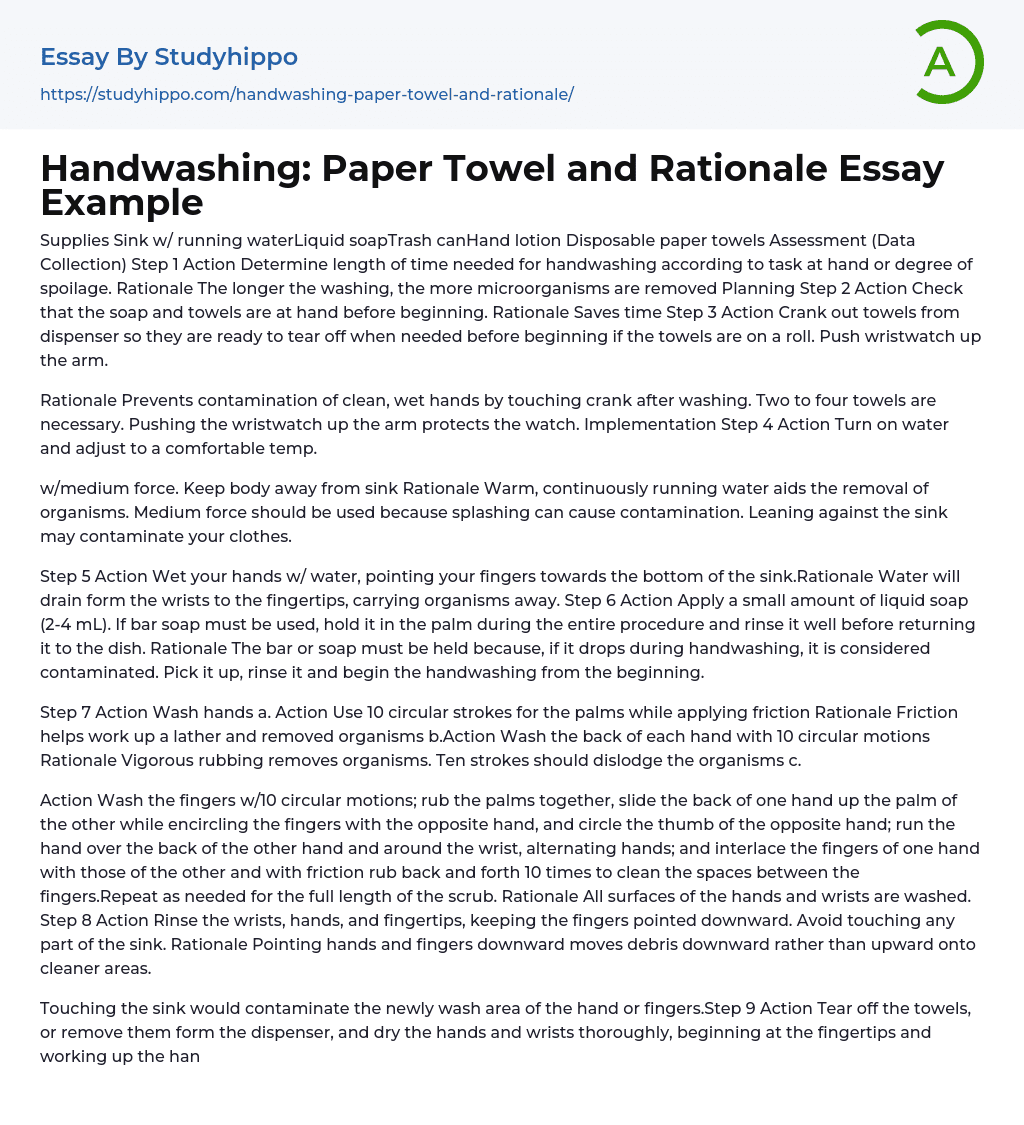Supplies:
Sink with running water
Liquid soap
Trash can
Hand lotion
Disposable paper towels
Assessment (Data Collection) Step 1:
Action: Determine the necessary duration for handwashing based on the task or level of contamination.
Rationale: The longer the washing, the more microorganisms are eliminated.
Planning Step 2:
Action: Confirm the availability of soap and towels before starting.
Rationale: Saves time.
Step 3:
Action: Retrieve towels from the dispenser and have them ready to use prior to washing (if they are on a roll). Push wristwatch up the arm.
Rationale: The reason for this action is to ensure that clean, wet hands do not get contaminated by touching the crank after washing. To achieve this, two to four t
...owels will be required. Pushing the wristwatch up the arm is also recommended to protect it. Implementation Step 4 Action: Turn on the water and adjust the temperature to a comfortable level.
It is recommended to use warm water that is continuously running to achieve effective removal of organisms. However, caution must be taken to avoid splashing and potential contamination by using medium force. Additionally, it is advised to refrain from leaning on the sink to avoid potential contamination of clothing.
In Step 5, wet your hands with water while pointing your fingers towards the bottom of the sink. This helps in draining water from wrists to fingertips, carrying away organisms.
In Step 6, apply a small amount of liquid soap (2-4mL). However, if bar soap must be used, make sure to hold it
in the palm during the entire procedure and rinse it well before returning it to the dish. This is because dropping the bar of soap during hand washing will contaminate it. In such a situation, pick it up, rinse it thoroughly, and start handwashing from the beginning.
Step 7: Wash hands.
a. Using 10 circular strokes on the palms while applying friction is recommended as it helps to work up a lather and remove organisms.
b. It is also important to wash the back of each hand with 10 circular motions as vigorous rubbing helps to remove organisms.
c. Aim for ten strokes during the washing process to effectively dislodge any remaining organisms.
The following instructions detail the proper way to wash your hands:
- Begin by washing your fingers in circular motions ten times.
- Rub your palms together before sliding the back of one hand up the palm of the other while encircling the fingers with the opposite hand.
- Circle the thumb of the opposite hand and run your hand over the back of each hand and around both wrists alternating hands.
- To clean spaces between fingers, interlace them by placing one hand over another and rubbing back and forth ten times.
Repeat these steps as needed to ensure all surfaces on hands and wrists are washed thoroughly. Finally, rinse your wrists, hands, and fingertips while keeping fingers pointed downward to move debris downward rather than upward onto cleaner areas. It is important not to touch any part of the sink during this process.
The newly washed area of the hands or fingers would become contaminated if the sink is touched. To
complete step 9, tear off towels or remove them from the dispenser and thoroughly dry hands and wrists, starting at the fingertips and moving up the hand. It is important to pat the skin gently instead of rubbing to prevent skin chapping.
When washing both your wrist and hand, make sure to use a fresh towel for each. Patting rather than rubbing can decrease the possibility of skin dryness. Once finished, use a dry paper towel to turn off the water if you need to touch any handles. However, make sure not to use your bare hands while touching them. Finally, dispose of the paper towel in a bin.
The importance of using a clean towel to prevent recontamination of washed hands is emphasized in step 11. Additionally, hand lotion should be applied if the hands are chapping to lubricate and keep the skin soft and prevent cracking. Step 12 involves evaluating whether the hands have been properly washed for the correct duration and are both clean and dry.
Inspect the skin for any cuts or sores to ensure effective hand cleaning. Recognizing skin breaks is crucial as they can allow microorganisms to enter.
- Birth Control essays
- Drug Addiction essays
- Eating Disorders essays
- Epidemiology essays
- Hiv essays
- Hygiene essays
- Obesity essays
- Social Care essays
- Teenage Pregnancy essays
- John Locke essays
- 9/11 essays
- A Good Teacher essays
- A Healthy Diet essays
- A Modest Proposal essays
- A&P essays
- Academic Achievement essays
- Achievement essays
- Achieving goals essays
- Admission essays
- Advantages And Disadvantages Of Internet essays
- Alcoholic drinks essays
- Ammonia essays
- Analytical essays
- Ancient Olympic Games essays
- APA essays
- Arabian Peninsula essays
- Argument essays
- Argumentative essays
- Art essays
- Atlantic Ocean essays
- Auto-ethnography essays
- Autobiography essays
- Ballad essays
- Batman essays
- Binge Eating essays
- Black Power Movement essays
- Blogger essays
- Body Mass Index essays
- Book I Want a Wife essays
- Boycott essays
- Breastfeeding essays
- Bulimia Nervosa essays
- Business essays
- Business Process essays
- Canterbury essays
- Carbonate essays
- Catalina de Erauso essays
- Cause and Effect essays
- Cesar Chavez essays
- Character Analysis essays




